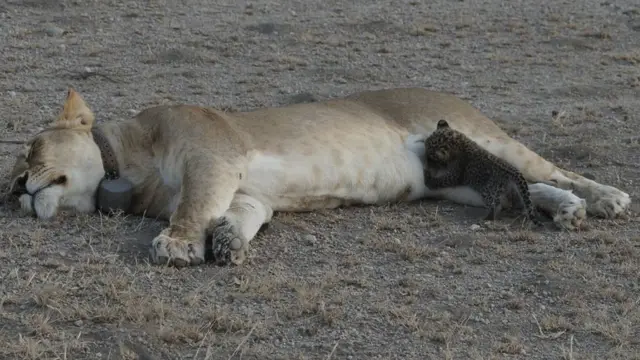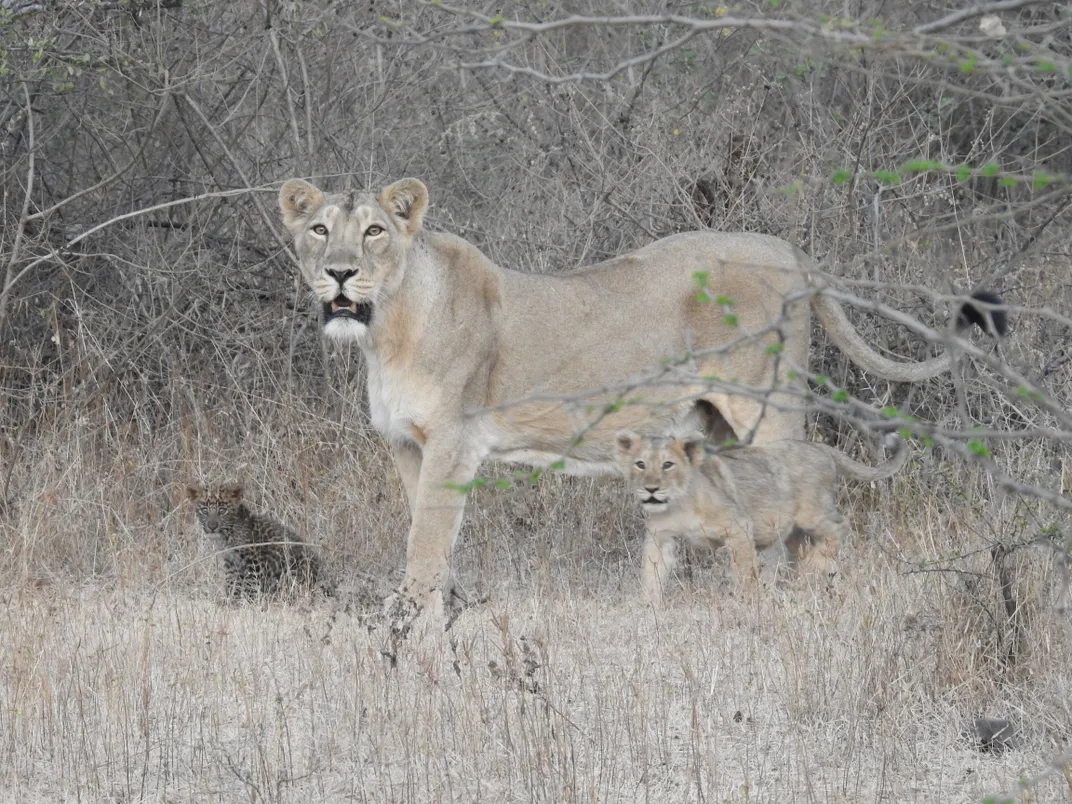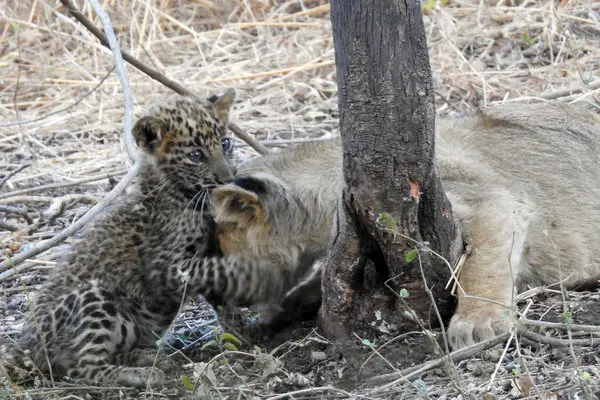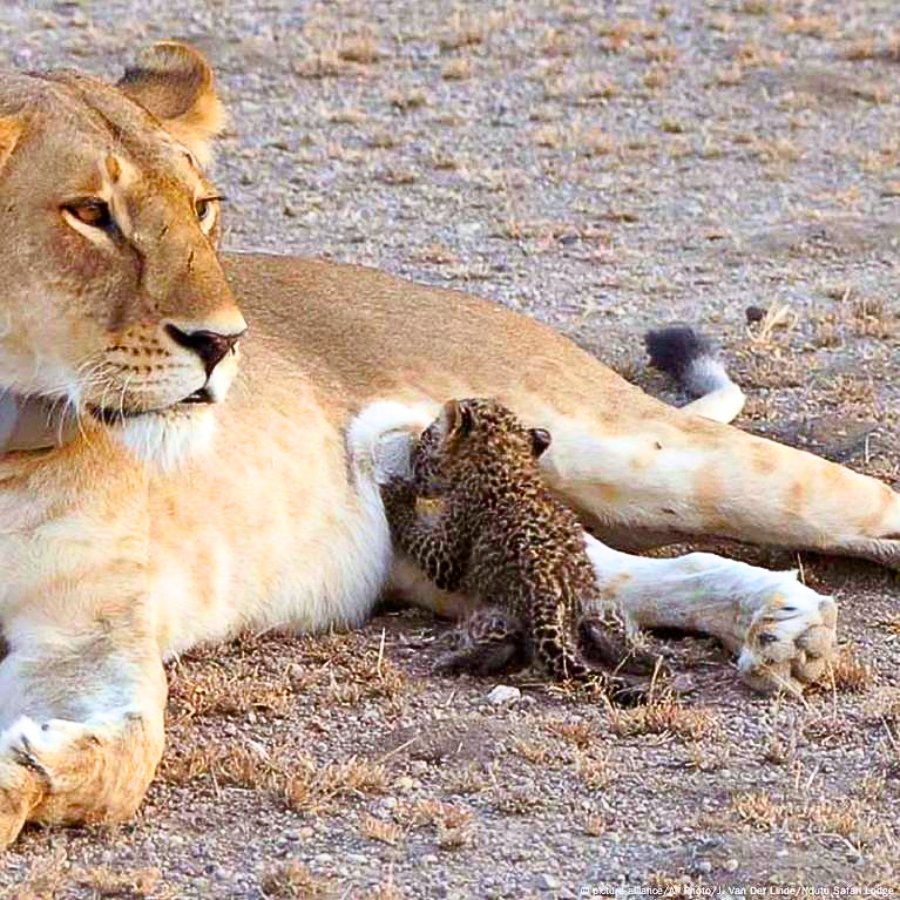Deep in India’s Gir National Park, researchers witnessed something no one thought possible — a lioness nursing a leopard cub, treating him as one of her own.
The discovery left wildlife experts stunned. Lions and leopards are natural rivals, not allies — yet here was a mother lion caring for a spotted baby that wasn’t hers.
A Family That Shouldn’t Exist
It began in December 2018, when field researchers spotted a lioness with two cubs about two months old — and a third, smaller baby covered in spots.
At first glance, they assumed it was another lion cub with an unusual coat. But as the animals moved closer, the truth came into focus: the tiny one was a leopard cub.
The lioness was nursing him alongside her own young, letting him feed from her kills and play with her cubs as though he belonged.
“They all got along just fine,” the researchers wrote in Ecosphere, calling the event “bizarre” and “unprecedented.”

Read Next: German Shepherd Loves Being Nanny, Continuously Adopting Orphaned Deer for Years
Why It Shouldn’t Have Happened
From an evolutionary standpoint, what this lioness did makes little sense.
Nursing and protecting young takes enormous energy — and in the wild, animals typically only do so to pass on their own genes.
Occasionally, animals adopt orphaned babies of their own species. For instance, female cheetahs have been known to take in unrelated cubs, helping them survive and later form coalitions with their own offspring.
But taking in a competitor’s cub? That’s virtually unheard of.
Lions and leopards compete for the same prey and territory. Adult lions often kill leopards to remove competition, and leopards are known to attack unguarded lion cubs.
“They are at perpetual odds,” said Stotra Chakrabarti, co-author of the study and animal behavior researcher at the University of Minnesota.
And yet, this lioness broke every rule of nature — showing not rivalry, but tenderness.
A Rare Act of Compassion
The little leopard was often seen lying beside his adoptive mother, playing with her cubs in the tall grass and drinking milk from her belly.
The three youngsters — two lions and one leopard — behaved like true siblings.
Over a 45-day observation period, researchers spotted the leopard cub with the lioness and her family 29 times.
He played, fed, and rested with them, never showing fear — and the lioness never showed aggression.
It wasn’t the first time a big cat had nursed another species’ young. In 2017, a lioness in Tanzania was briefly seen suckling a leopard cub, but that encounter lasted just one day. This, however, was far more: a full-fledged adoption.

Also Read: Heroic Boy Risks Life to Save a Baby Deer From Drowning in Raging Flood
A Tragic End to a Beautiful Story
Sadly, the extraordinary relationship didn’t last forever.
In February 2019 — about two months after the first sighting — the leopard cub’s body was discovered near a watering hole.
There were no signs of violence. A necropsy revealed that he had suffered from a congenital femoral hernia, a fatal internal condition.
His death wasn’t caused by attack or neglect — just the cruel randomness of nature.
Researchers mourned his loss, not just for what it meant biologically, but for what it symbolized: a rare, fragile bridge between two enemies.
Why Did the Lioness Do It?
No one can say for certain what drove the lioness to take in the leopard cub.
But scientists suspect her maternal instincts simply overrode any sense of rivalry.
At around five or six years old, she was a young mother. Her first litter had died early, and this was her first successful experience raising cubs.
Her hormones, they say, may have been in overdrive — blurring the boundaries between “mine” and “not mine.”
“Given that she was a lactating mother with cubs of her own, her maternal and hormonal instincts could have overridden her recognition,” the study notes.
An Unlikely Opportunity in Isolation
Another factor might have been social isolation.
Unlike African lions, Asiatic lions (found in Gir National Park) tend to live more solitary lives.
Females raise their young alone for months, while males only join when mating or sharing large kills.
This isolation might have protected the odd family from other lions who would’ve likely killed the leopard cub.
In solitude, the lioness had the freedom to follow instinct — and that instinct told her to nurture.

When Nature Defies Its Own Rules
Interspecies adoption is one of the rarest behaviors in the animal kingdom. Only two other clear examples have ever been documented — a marmoset adopted by capuchins in 2006, and a bottlenose dolphin mother raising a melon-headed whale calf for over three years.
But both cases involved peaceful species with overlapping behaviors — not predators that regularly kill each other.
That’s what makes this story different.
A lion — one of nature’s most territorial animals — accepted a rival’s cub without hesitation.
“It would have been fascinating to see how things developed if the leopard had survived,” Chakrabarti told The New York Times.
“Would he have grown up thinking he was a lion? We’ll never know.”
A Glimpse Into the Heart of the Wild
For all its violence and survival instinct, nature sometimes surprises us with compassion.
In this corner of India, for a brief window of time, a lioness — driven by nothing but maternal love — broke every evolutionary rule.
She didn’t see a rival. She saw a baby who needed her.
And for 45 days, she gave him something his real mother couldn’t — safety, warmth, and belonging.



